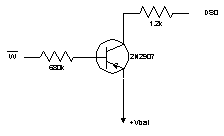In this TI-66, memory always read a '1' in the 1 bit, causing numbers and program instructions to be corrupted. For instance, after clearing a register, its contents read 1.1111111E11. Having recently acquired replacement memory chips, I decided to try a replacement here, but to no avail; the problem remained. The conclusion was that the failure is on the main logic chip, i.e., the calculator is not repairable. However, I didn't give up; I decided to give it another try. Disconnecting the processor from the affected bit in memory, I was able to confirm that the processor is able to read data just fine; the problem was with writing data. I was also able to confirm that what the processor reads as a '1' actually appears as a logic 'low' in RAM and vice versa. I now had a simple plan: why don't I try and 'help' the processor with a pull-up resistor? Assuming its output circuit is damaged, but still provides a weakened signal, maybe a resistor with the right value will be sufficient to reliably fix the problem? Guess what... it worked. Experimentation showed that connecting the affected bit to power via a 1.2k resistor fixed the problem, and the machine began to operate normally. Not for too long, unfortunately; after a few minutes, I noticed that bit errors began to appear. I also noticed signs that the batteries might be weakening! A quick measurement confirmed that there was excessive current draw via my newly installed resistor, and the solution was also sensitive to battery voltage. So I tried another solution. After all, I only need the pull-up resistor when the processor is actually writing to memory; and I know very well when that is, because there's a separate write signal that I can tap. So instead of connecting the resistor directly, I decided to insert a transistor controlled by the write signal to switch on the resistor when needed:
This solution solved the problem with excessive current nicely. The calculator remains sensitive to decreasing battery voltage, but it appears to operate well for a reasonable range of normal battery voltages.



